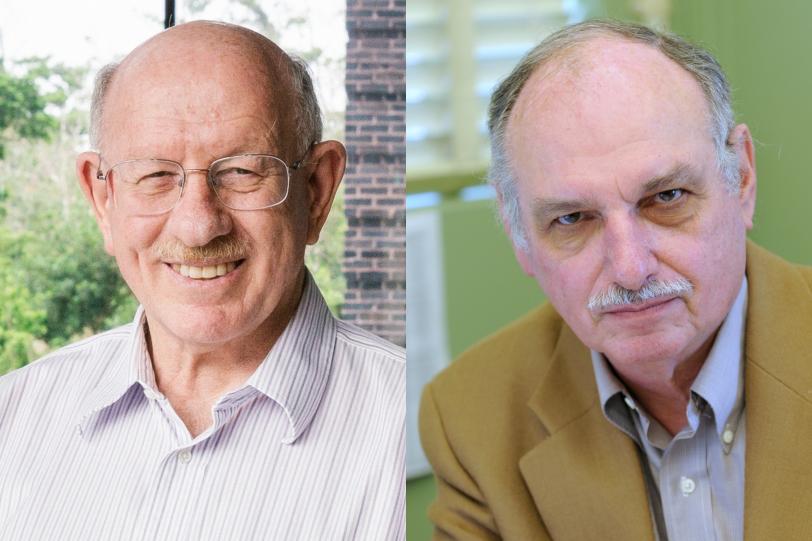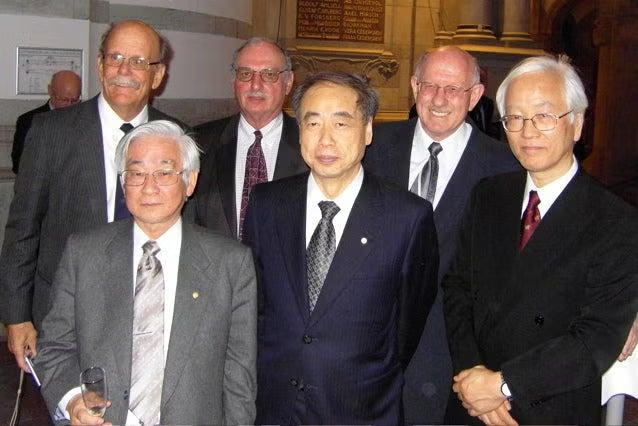Jonathan Dorfan and David Hitlin Receive 2016 Panofsky Prize
Award Honors Researchers’ Leading Role in BABAR Particle Physics Experiment
The American Physical Society has honored two key figures of the BABAR particle physics experiment at the Department of Energy’s SLAC National Accelerator Laboratory with the 2016 W.K.H. Panofsky Prize in Experimental Particle Physics: SLAC Director Emeritus Jonathan Dorfan and California Institute of Technology Professor David Hitlin. They share the award with Stephen Olsen and Fumihiko Takasaki, two lead researchers of the Belle experiment in Japan.
BABAR and Belle both began taking data within days of each other in the summer of 1999 to study unstable particles known as B mesons. By 2001 they had found experimental evidence for differences in the way B mesons and their antiparticles decay into other particles. This matter-antimatter decay asymmetry, caused by what is called CP violation, could help shine light on why the universe is made of matter rather than a mixture of matter and antimatter. These precise measurements provided crucial confirmation of a theory developed in 1973 by theorists Makoto Kobayashi and Toshihide Maskawa, who went on to receive the 2008 Nobel Prize in Physics.
Today’s announcement of the 2016 Panofsky Prize cites Dorfan, Hitlin, Olsen and Takasaki for “leadership in the BABAR and Belle experiments, which established the violation of CP symmetry in B meson decay and furthered our understanding of quark mixing and quantum chromodynamics.”
“The BABAR research program was an important milestone for the lab and continues to be productive today,” says JoAnne Hewett, head of SLAC’s Elementary Particle Physics Division. “The Panofsky Prize is a prestigious award, and we are very proud that Jonathan and David have been recognized for their achievements in making this program happen.”
The prize, named after SLAC’s founding director Wolfgang “Pief” Panofsky, includes a $10,000 award and is presented annually to recognize and encourage outstanding achievements in experimental particle physics.
“It’s wonderful to be recognized together with my close friend and mentor David and our colleagues from Belle,” Dorfan says. “We have had plenty of opportunities to enjoy the fruits of our science, and this prize is the icing on the cake. I knew Pief very well. I began my career at SLAC when he was the lab director, and I benefitted from his leadership and friendship in countless ways. To win a prize in his name is a great honor.”
B Factories Race to Discovery
To study the nature of CP violation in greater detail than ever before, SLAC launched the construction of the PEP-II accelerator in 1994 as the centerpiece of the lab’s high-energy physics program. Only five years later, it began smashing together powerful beams of electrons and their antimatter siblings, positrons, generating large amounts of B mesons, whose decays were then captured with the newly built BABAR detector.
At the same time, researchers in Japan pursued a very similar approach with the Belle experiment at the KEKB collider. Both experiments were also referred to as B factories and were based on the novel idea of two separate electron and positron beams at different energies brought together at the center of the BABAR and Belle detectors.
“Belle and BABAR were in a race to become first to measure CP violation in the B meson system,” Hitlin says. “The competition was intense and stimulating at the same time. I think the race was good for both sides.”
In 2001, both B factories announced independently that they had succeeded in the discovery of CP violation in neutral B meson decays. Both experiments went on to complete a comprehensive study of CP violation in many different decay modes, thereby providing the foundation of our understanding of this phenomenon within the Standard Model, the most accurate theoretical description of fundamental particles and forces.
“It was a remarkable accomplishment to put together BABAR and Belle as new, major international collaborations, and to design and construct the innovative detectors in a very short period of time,” says Burton Richter, who was SLAC director from 1984 to 1999. “David and Jonathan were critical to galvanizing the accelerator and detector communities behind the incredible science opportunity that came with nailing down CP violation in the B meson system.”
Recognition of BABAR Leadership
Jonathan Dorfan directed the construction of the PEP-II accelerator and eventually also became the technical coordinator for the BABAR detector. After joining SLAC as a postdoc in 1976, he became SLAC professor in 1984 and SLAC associate director in 1994. From 1999 to 2007, Dorfan was SLAC director. He is now president and CEO of the Okinawa Institute of Science and Technology Graduate University in Japan.
“PEP-II and BABAR were configured in a novel way, so as to optimize the measurements of CP violation,” he says. “PEP-II performed 100 times better than other electron-positron colliders at the time, which is one of the reasons why our results came out so beautifully.”
David Hitlin was founding spokesperson of the BABAR experiment from 1994 to 2000 and played a crucial role in getting the BABAR collaboration going – a group of 600 physicists and engineers from 75 institutions in 13 countries. Hitlin started his research career as a postdoc at SLAC from 1969 to 1972 and was a SLAC assistant professor from 1975 to 1979. He has been a professor at Caltech since 1979.
“Our single most important achievement was to prove that Kobayashi’s and Maskawa’s theory of CP violation is correct,” Hitlin says. “But the richness of BABAR’s entire physics program has also been extremely important.”
Outstanding Physics Capabilities
In fact, BABAR researchers studied far more than CP violation. As of today, the collaboration has published 550 scientific publications, including precise measurements of the properties of elementary particles known as bottom quarks, charm quarks and tau leptons, as well as searches for physics beyond the Standard Model.
Novel technologies developed for PEP-II and BABAR were also instrumental for other major SLAC projects, Dorfan says, including the main scientific instrument on the Fermi Gamma-ray Space Telescope, a NASA-led space mission designed to capture high-energy radiation reaching the Earth from space, and an upgrade to the accelerator backbone of the Stanford Synchrotron Radiation Lightsource (SSRL), a DOE Office of Science User Facility that generates powerful X-rays.
Although operation of BABAR and Belle ended in 2008 and 2010, respectively, data analysis continues to this day.
“It’s wonderful to see the tremendous contributions made by the key individuals of both B factories recognized with the Panofsky Prize,” says BABAR spokesperson Michael Roney of the University of Victoria in Canada. “Their groundbreaking work has opened new windows for discovery, and we look forward to exciting new advances in the field.”
Studies of CP violation in the B meson system continue with the current LHCb experiment at CERN, the European particle physics laboratory, and the future Belle II experiment in Japan. Both experiments hope to find deviations from the Standard Model that would hint at unexpected new physics.
For questions or comments, contact the SLAC Office of Communications at communications@slac.stanford.edu.
SLAC is a multi-program laboratory exploring frontier questions in photon science, astrophysics, particle physics and accelerator research. Located in Menlo Park, Calif., SLAC is operated by Stanford University for the U.S. Department of Energy's Office of Science.
SLAC National Accelerator Laboratory is supported by the Office of Science of the U.S. Department of Energy. The Office of Science is the single largest supporter of basic research in the physical sciences in the United States, and is working to address some of the most pressing challenges of our time. For more information, please visit science.energy.gov.







